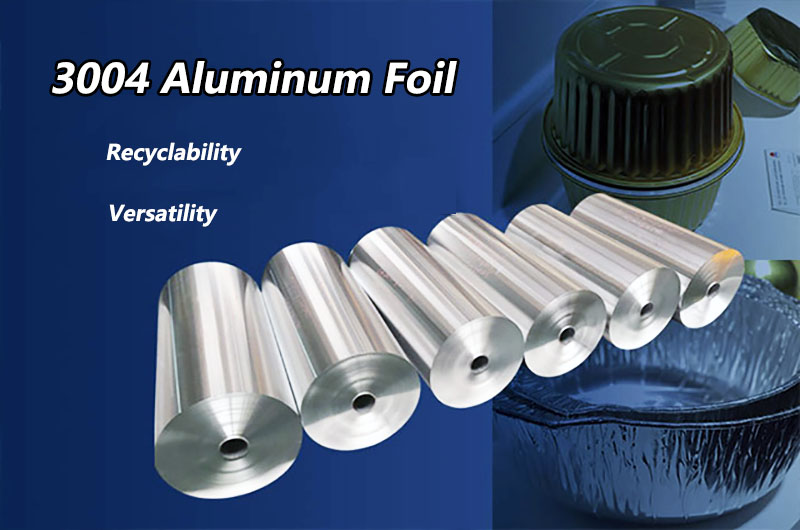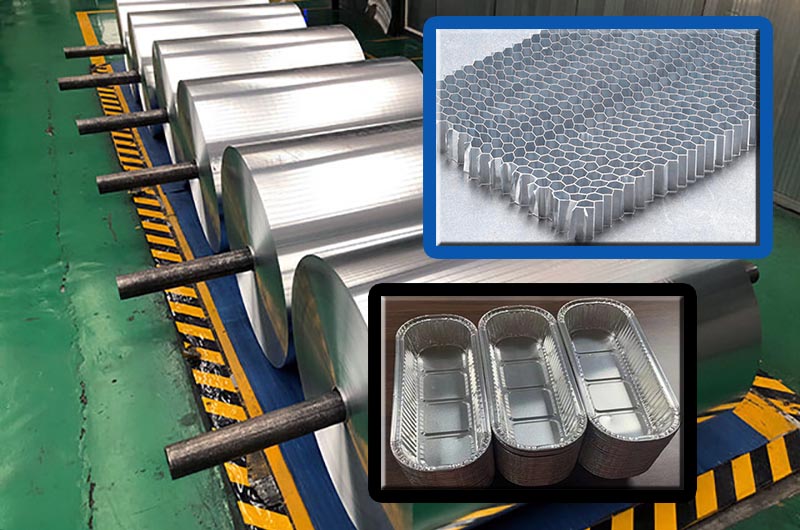- 3004 Aluminum Foil Specifications
- Advantages of 3004 Aluminum Foil
- 3004 Aluminum Foil Common Thicknesses and Applications
- 3004 Aluminum Foil Composition and Alloying Elements
- 3004 Aluminum Foil Mechanical Properties
- 3004 Aluminum Foil Mechanical properties
- 3004 Aluminum Foil Chemical Properties
- 3004 Aluminum Foil Applications
- Application Examples of 3004 Aluminum Foil
- 3004 Aluminum Foil Producting Process
- People also Search about 1145 Aluminum Foil
In the realm of aluminum alloys, each variant serves a distinct purpose, and among them, 3004 aluminum foil stands out as a versatile and reliable material. Widely employed in various industries, this alloy offers a unique combination of attributes that make it indispensable for numerous applications.
From packaging solutions to automotive components, understanding the properties and applications of 3004 aluminum foil unveils its significance in modern manufacturing.
3004 aluminum foil is widely used in food packaging, container foil, aluminum foil lunch boxes, and honeycomb aluminum foil.

3004 Aluminum Foil Specifications
| Property | Specification |
|---|---|
| Producible State of Matter | Rolled or Sheet Form |
| Temper | F, O, H12, H14, H16, H18, H19, H22, H24, H26, H28, H114 |
| Thickness (mm) | 0.02 mm to 0.2 mm (Typical Range) |
| Width (mm) | 100 mm to 1600 mm (Typical Range) |
| Length (mm) | Customizable; Typically supplied in rolls or coils |
Advantages of 3004 Aluminum Foil
- Recyclability: Highly recyclable, aligning with sustainability goals and reducing environmental impact.
- Thermal Conductivity: Good thermal conductivity is valuable for efficient heat transfer in various applications.
- Lightweight: Inherent lightweight nature contributes to fuel efficiency and ease of handling.
- Versatility: Well-suited for diverse applications, from packaging to automotive components.
- Aesthetic Appeal: Natural metallic luster enhances visual appeal, making it suitable for architectural elements.
3004 Aluminum Foil Common Thicknesses and Applications
Thin Thickness (0.02 mm - 0.05 mm) 3004 Aluminum Foil
Applications:
Packaging: Ideal for thin, lightweight packaging of food and pharmaceutical products.
Flexible Laminates: Used in flexible laminates for various industries.
Medium Thickness (0.05 mm - 0.1 mm) 3004 Aluminum Foil
Applications:
HVAC Components: Suitable for manufacturing heat exchangers and condenser fins in HVAC systems.
Automotive: Used for lightweight structural components in the automotive industry.

Standard Thickness (0.1 mm - 0.15 mm) 3004 Aluminum Foil
Applications:
Construction: Commonly employed in roofing and cladding for its balance of strength and weight.
General Manufacturing: Versatile thickness for various applications requiring formability.
Thick Thickness (0.15 mm - 0.2 mm) 3004 Aluminum Foil
Applications:
Structural Components: Utilized in applications where higher strength and durability are critical.
Architectural Elements: Suitable for thicker sections in architectural design and construction.
3004 Aluminum Foil Composition and Alloying Elements
3004 aluminum belongs to the wrought aluminum-manganese family. The alloy is composed primarily of aluminum, with manganese as the predominant alloying element. Small amounts of magnesium are also present, contributing to the alloy's overall strength and corrosion resistance. This precise composition gives 3004 aluminum foil a distinct set of mechanical and chemical properties.
3004 Aluminum Foil Mechanical Properties
Strength and Durability
The inclusion of manganese enhances the strength of the alloy, making it suitable for applications requiring structural integrity.
Formability
3004 aluminum foil exhibits excellent formability, allowing it to be easily shaped and manipulated for various manufacturing processes.
Weldability
Weldability is a crucial factor in many industries. Fortunately, 3004 aluminum foil can be welded using conventional methods, providing flexibility in fabrication.
3004 Aluminum Foil Mechanical properties
| Alloy | 3004 |
|---|---|
| Tensile strength | 215 MPa |
| Yield strength | 170 MPa |
| Shear strength | 115 MPa |
| Fatigue strength | 105 MPa |
| Elastic modulus | 70-80 GPa |
| Poisson's ratio | 0.33 |
| Elongation | 10% |
| Hardness | 52 |
3004 Aluminum Foil Chemical Properties
Corrosion Resistance
The alloy's resistance to corrosion makes it ideal for applications in which exposure to moisture or harsh environmental conditions is common.
Chemical Stability
3004 aluminum foil maintains stability when in contact with a variety of substances, contributing to its reliability in different industrial settings.
3004 Aluminum Foil Applications
3004 Packaging Aluminum Foil
3004 aluminum foil is extensively used in the packaging industry for its ability to withstand various storage conditions. It is employed in flexible packaging, such as pouches and lids, due to its formability and barrier properties.
1. 3004 Food Packaging Aluminum Foil. 3004 aluminum foil can be used in ziplock bags such as dried fruits, BBQ, dessert baking, and other food packages.
2. 3004 Container Lunch Box. 3004 aluminum foil can also be used as a lunch box material. The thickness of commonly used 3004 aluminium foil for container lunch boxes is generally between 0.03mm and 0.20mm.
3004 aluminum foil is suitable for processing single-cavity aluminum foil lunch boxes, Compared with other brands of aluminum products, it has high strength and deformation resistance.
3. 3004 Aluminum Foil Container: The aluminum foil container made by Haomei 3004 aluminum foil is of higher strength than 3003 aluminum foil. 3004 alu foil has both the price advantage of 8011 and the strength advantage of 3003 aluminum foil.
3004 foil container has a neat appearance and good thermal conductivity. It can be directly heated on the original packaging with kitchen utensils such as ovens, microwave ovens, and steamers.

3004 Honeycomb Aluminum Foil
The aluminum honeycomb core is a hexagonal aluminum honeycomb structure. It has good mechanical properties, good durability and thermal conductivity. The aluminum honeycomb core material adopts 3004h18 or 3004h19 aluminum foil. 3004 aluminum foil has high flatness, good shape, high strength and is not easy to deform after processing.
3004 Air Conditioner Aluminum Foil
The common aircon aluminum foil has 1100/3003/3004/8011 alloy, etc. 3004 aluminium foil for air conditioner heat exchanger fin material belongs to Al-Mn alloy, which has good corrosion resistance, excellent formability, high strength and elongation, etc., and meets the mechanical performance requirements of air-conditioning foil.
Automotive Components
3004 aluminum foil finds applications in the automotive sector, where its combination of strength and formability is valuable for manufacturing components like heat exchangers and condensers.
3004 Aluminum Foil for Roof Construction
In the construction industry, this alloy is utilized for roofing and cladding due to its corrosion resistance and ability to withstand harsh weather conditions.
As the world increasingly focuses on sustainability, the environmental impact of materials is a crucial consideration. Aluminum, in general, is highly recyclable, and 3004 aluminum foil is no exception.
3004 aluminum foil recyclability not only reduces the demand for primary aluminum but also minimizes the overall carbon footprint of the industries utilizing it.
Application Examples of 3004 Aluminum Foil
- 3004-O aluminum container foil
- Prefabricated aluminum foil food box material 3004 aluminum foil
- 3004 aluminum foil for aluminum honeycomb core in new energy carriages
- 3004 decorative aluminum foil
- 3004 aluminum foil for aluminum-plastic composite
- 3004 aluminum foil for single chamber lunch boxes
- 3004 aluminum foil for heat transfer fins of air conditioning heat exchangers
- 3004h18 honeycomb aluminum foil
- Honeycomb core raw material 3003 aluminum foil
- Aluminum honeycomb core substrate 3004-h18 aluminum foil
- 3004 aluminum foil for bread tray aluminum foil box
- 3004 aluminum foil for aluminum alloy wine caps
- 3004 aluminum foil for food packaging boxes
3004 Aluminum Foil Producting Process
The production of 3004 aluminum foil involves several key steps, including casting, rolling, annealing, and finishing processes. Here's a concise overview of the typical production process:
- Aluminum Alloy Preparation
- Casting
- Homogenization
- Hot Rolling
- Cold Rolling
- Annealing
- Quality Control
- Packaging and Shipping
People also Search about 1145 Aluminum Foil
- What is 3004 aluminum used for?
- What is the difference between 3003 and 3004 aluminum?
- What is melting point of aluminum alloy 3004?
- What grade of aluminum is aluminum foil?
